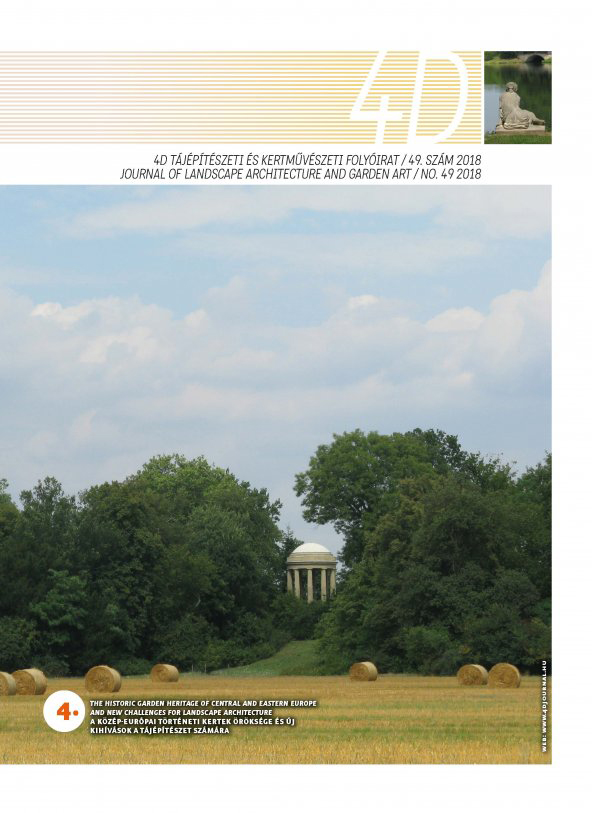Tájjellegváltozás képi érzékelésének értelmezése kérdőíves vizsgálattal 2D Google Eart-felvételek alkalmazásával
Kulcsszavak:
tájjellegváltozás, képi érzékelés, kérdőíves vizsgálat, 2D, google earthAbsztrakt
A területhasználat és a felszínborítás változása jelentős részben a gazdasági folyamatokat befolyásoló európai politikák következménye. E változások fenntarthatóságra gyakorolt hatásainak értékelésére szolgáló módszert dolgozott ki az EU 6. Kutatási keretprogramja által finanszírozott SENSOR projekt. A kifejlesztett digitális modell a „SIAT” (Sustainability Impact Assessment Tool) egy döntéstámogató eszköz, amely különböző jövőbeni területhasználat-változási szcenáriók következményeit mutatja be a betáplált indikátorok által, jelölve hogy mennyire felel meg a fenntarthatóság kritériumainak. A projektben a fenntarthatósági hatásvizsgálatban alkalmazható, területhasználat változására érzékeny tájindikátorokat a Soproni Egyetem tájkutató csoportja dolozta ki. A két indikátor, amelyeket e lap hasábjain ismertettünk, a felszínborítás állandóságát, illetve változását, valamint a vizuális attraktivitást méri.
Hivatkozások
Farrington J., Kuhlmann, T., Rothman, D. S., Imrichnowa, Z., Reid, L., Konkoly Gyuro, E. 2008: Reflections on Social and Economic Indicators for Land Use Change. In: Helming, P. T., M. Perez-Soba (Ed.): Sustainability Impact Assessment of Land Use Changes. Berlin Heidelberg New York: Springer. pp. 325–349. https://doi.org/10.1007/978-3-540-78648-1_17
Helming K.; Pérez-Soba M.; Tabbush P. 2008: Sustainability Impact Assessment of Land Use Changes. Springer-Verlag Berlin and Heidelberg GmbH & Co. KG. Berlin, Germany. https://doi.org/10.1007/978-3-540-78648-1
Verweij P. J. F. M.; Sieber B.; Wien J. J. F.; Müller K. 2006: SIAT, a Sustainable Impact Assessment Tool for Understanding the drivers in integrated impact assessment. International Conference IEMSS, Vol. Vermont USA.
Konkoly-Gyuró É.; Jombach S.; Tatai Z. 2008: A tájidentitás indikátorai európai fenntarthatósági hatásvizsgálatban. (Indicators of landscape identity in the European Sustainability Impact Assessment) 4D Tájépítészeti és Kertművészeti Folyóirat, Vol. 9. pp. 52–59.
Konkoly-Gyuró É.; Jombach S.; Tatai Z. 2008: A tájidentitás indikátorai európai fenntarthatósági hatásvizsgálatban. (Indicators of landscape identity in the European Sustainability Impact Assessment). 4D Tájépítészeti és Kertművészeti Folyóirat, Vol. 9. pp. 52–59.
Jombach S. 2012: Távérzékelés és a térinformatikai feldolgozás szerepe a tájkarakter-elemzésben.( The role of remote sensing and geospatial processing in landscape character assessment). In: Sallay, Á. (Ed.): Tájmetria/Tájértékelés. Budapesti Corvinus Egyetem Tájépítészeti Kar. Budapest. pp. 29-41.
Hehl-Lange S. 2001: Structural elements of the visual landscape and their ecological functions. Landscape and Urban Planning, Vol. 54(1–4). pp. 107–115. https://doi.org/10.1016/S0169-2046(01)00129-3
Lange E.; Bishop I. 2001: Our visual landscape: analysis, modeling, visualization and protection. Landscape and Urban Planning, Vol. 54(1–4). pp. 1–3. https://doi.org/10.1016/S0169-2046(01)00121-9
Tress B.; Tress G.; Décamps H.; d’Hauteserre A.-M. 2001: Bridging human and natural sciences in landscape research. Landscape and Urban Planning, Vol. 57(3–4). pp. 137–141. https://doi.org/10.1016/S0169-2046(01)00199-2
Tahvanainen L.; Ihalainen M.; HietalaKoivu R.; Kolehmainen O.; Tyrväinen L.; Nousiainen I.; Helenius J. 2002: Measures of the EU Agri-Environmental Protection Scheme (GAEPS) and their impacts on the visual acceptability of Finnish agricultural landscapes. Journal of Environmental Management, Vol. 63(3). pp. 213–227. https://doi.org/10.1006/jema.2002.0489
Kollányi L.; Jombach S. 2008: Vizuális esztétikai tájelemzések. (Visual-aesthetical landscape assessments). In: Szabó, V.; Orosz, Z.; Nagy, R. (Eds.): Fazekas I IV. Magyar Földrajzi Konferencia, Debreceni Egyetem. Debrecen. 230–236.
Jombach S.; Kollányi L.; Szabó Á.; Filepné K. K.; Nagy G. G.; Molnár L. J.; T T. D.; V M.; Szilvácsku Z.; Sallay Á.; Valánszki I.; Csemez A. 2014: Visualisation and landscape modelling to understand landscapes in transition (Landscape management of “Nagyberek”, Hungary). In: Maja Simoneti, U. K. (Ed.). Ceske Budejovice. pp. 81–93.
Scott M. J.; Canter D. V. 1997: Picture or place? A multiple sorting study of landscape. Journal of Environmental Psychology, Vol. 17(4). pp. 263–281. https://doi.org/10.1006/jevp.1997.0068
Wherrett J. R. 1999: Issues in using the Internet as a medium for landscape preference research. Landscape and Urban Planning, Vol. 45(4) pp. 209–217. https://doi.org/10.1016/S0169-2046(99)00053-5
Clay G. R., Daniel T. C. 2000: Scenic landscape assessment: the effects of land management jurisdiction on public perception of scenic beauty. Landscape and Urban Planning, Vol. 49(1–2). pp. 1–13. https://doi.org/10.1016/S0169-2046(00)00055-4
Tveit M. S. 2009: Indicators of visual scale as predictors of landscape preference; a comparison between groups. Journal of Environmental Management, Vol. 90(9). pp. 2882–2888. https://doi.org/10.1016/j.jenvman.2007.12.021
Martín B.; Ortega E.; Otero I.; Arce R. M. 2016: Landscape character assessment with GIS using map-based indicators and photographs in the relationship between landscape and roads. Journal of Environmental Management, Vol. 180. pp. 324–334. https://doi.org/10.1016/j.jenvman.2016.05.044
Wissen U.; Schroth O.; Lange E.; Schmid W. A. 2008: Approaches to integrating indicators into 3D landscape visualisations and their benefits for participative planning situations. Journal of Environmental Management, Vol. 89(3) pp. 184–196. https://doi.org/10.1016/j.jenvman.2007.01.062
Eplényi A. 2015: A táj mintázatai.(Patterns of landscape) 4D Tájépítészeti és Kertművészeti Folyóirat, Vol. 43(37) pp. 22–45.
Appleton K.; Lovett A.; Sünnenberg G.; Dockerty T. 2002: Rural landscape visualisation from GIS databases: a comparison of approaches, options and problems. Computers, Environment and Urban Systems, Vol. 26(2–3). pp. 141–162. https://doi.org/10.1016/S0198-9715(01)00041-2
Wissen U.; Schroth O.; Lange E.; Schmid W. A. 2008: Approaches to integrating indicators into 3D landscape visualisations and their benefits for participative planning situations. Journal of Environmental Management, Vol. 89(3) pp. 184–196. https://doi.org/10.1016/j.jenvman.2007.01.062
Tress B.; Tress G. 2003: Scenario visualisation for participatory landscape planning—a study from Denmark. Landscape and Urban Planning, Vol. 64(3) pp. 161–178. https://doi.org/10.1016/S0169-2046(02)00219-0
Dockerty T.; Lovett A.; Sünnenberg G.; Appleton K.; Parry M. 2005: Visualising the potential impacts of climate change on rural landscapes. Computers, Environment and Urban Systems, Vol. 29(3) pp. 297–320. https://doi.org/10.1016/j.compenvurbsys.2004.05.004
Soliva R.; Rønningen K.; Bella I.; Bezak P.; Cooper T.; Flø B. E.; Marty P.; Potter C. 2008: Envisioning upland futures: Stakeholder responses to scenarios for Europe's mountain landscapes. Journal of Rural Studies, Vol. 24(1) pp. 56–71. https://doi.org/10.1016/j.jrurstud.2007.04.001
Jombach S.; Kollányi L.; Sallay Á.; Csemez A.; Egyed A.; Tatai Z. 2010. ViLaCOrDEM. Special processing of orthophotographs in landscape change visualisation, Buhmann/Pietsch/Kretzler (Eds.) Digital Landscape Architecture 2010 at Anhalt University of Applied Sciences Buhmann/Pietsch/Kretzler (Eds.) Digital Landscape Architecture 2010 at Anhalt University of Applied Sciences: Aschersleben, Németország.pp. 313–321.
Doyle S.; Dodge M.; Smith A. 1998: The potential of Web-based mapping and virtual reality technologies for modelling urban environments. Computers, Environment and Urban Systems, Vol. 22(2) pp. 137–155. https://doi.org/10.1016/S0198-9715(98)00014-3
Appleton K.; Lovett A. 2005: GIS-based visualisation of development proposals: reactions from planning and related professionals. Computers, Environment and Urban Systems, Vol. 29(3) pp. 321–339. https://doi.org/10.1016/j.compenvurbsys.2004.05.005
Schroeder H.; Daniel T. C. 1981: Progress in predicting the perceived scenic beauty of forest landscapes. Forest Science Vol. 27. pp. 71–80.
Kellomäki S.; Savolainen R. 1984: The scenic value of the forest landscape as assessed in the field and the laboratory. Landscape Planning, Vol. 11(2) pp. 97–107. https://doi.org/10.1016/0304-3924(84)90033-9
Brown T. C.; Daniel T. C. 1986: Predicting scenic beauty of timber stands. Forest Science, Vol. 32. pp. 471–487. https://doi.org/10.1093/forestscience/32.2.471
Pukkala T.; Kellomäki S.; Mustonen E. 1988: Prediction of the amenity of a tree stand. Scandinavian Journal of Forest Research, Vol. 3(1-4) pp. 533–544. https://doi.org/10.1080/02827588809382538
Jensen F. S. 1993: Landscape managers' and politicians' perception of the forest and landscape preferences of the population. Forest and Landscape Research Vol. 1. pp. 79–93.
Bell S. 2001: Landscape pattern, perception and visualisation in the visual management of forests. Landscape and Urban Planning, Vol. 54(1–4). pp. 201–211. https://doi.org/10.1016/S0169-2046(01)00136-0
Tahvanainen L.; Tyrväinen L.; Ihalainen M.; Vuorela N.; Kolehmainen O. 2001: Forest management and public perceptions — visual versus verbal information. Landscape and Urban Planning, Vol. 53(1–4). pp. 53–70. https://doi.org/10.1016/S0169-2046(00)00137-7
Ribe R. G. 2005: Aesthetic perceptions of green-tree retention harvests in vista views: The interaction of cut level, retention pattern and harvest shape. Landscape and Urban Planning, Vol. 73(4) pp. 277–293. https://doi.org/10.1016/j.landurbplan.2004.07.003
Sheppard S. R. J.; Meitner M. 2005: Using multi-criteria analysis and visualisation for sustainable forest management planning with stakeholder groups. Forest Ecology and Management, Vol. 207(1–2) pp. 171–187. https://doi.org/10.1016/j.foreco.2004.10.032
Cook P. S.; Cable T. T. 1995: The scenic beauty of shelterbelts on the Great Plains. Landscape and Urban Planning, Vol. 32(1) pp. 63–69. https://doi.org/10.1016/0169-2046(94)00171-X
Appleton K.; Lovett A.; Sünnenberg G.; Dockerty T. 2002: Rural landscape visualisation from GIS databases: a comparison of approaches, options and problems. Computers, Environment and Urban Systems, Vol. 26(2–3) pp. 141–162. https://doi.org/10.1016/S0198-9715(01)00041-2
Appleton K.; Lovett A. 2003: GIS-based visualisation of rural landscapes: defining ‘sufficient’ realism for environmental decision-making. Landscape and Urban Planning, Vol. 65(3) pp. 117–131. https://doi.org/10.1016/S0169-2046(02)00245-1
van Zanten B. T.; Zasada I.; Koetse M. J.; Ungaro F.; Häfner K.; Verburg P. H. 2016: A comparative approach to assess the contribution of landscape features to aesthetic and recreational values in agricultural landscapes. Ecosystem Services, Vol. 17. pp. 87–98. https://doi.org/10.1016/j.ecoser.2015.11.011
Clay G. R.; Daniel T. C. 2000: Scenic landscape assessment: the effects of land management jurisdiction on public perception of scenic beauty. Landscape and Urban Planning, Vol. 49(1–2) pp. 1–13. https://doi.org/10.1016/S0169-2046(00)00055-4
Madureira L.; Nunes L. C.; Borges J. G.; Falcão A. O. 2011: Assessing forest management strategies using a contingent valuation approach and advanced visualisation techniques: A Portuguese case study. Journal of Forest Economics, Vol. 17(4) pp. 399–414. https://doi.org/10.1016/j.jfe.2011.04.001
Zhao J.; Luo P.; Wang R.; Cai Y. 2013: Correlations between aesthetic preferences of river and landscape characters. Journal of Environmental Engineering and Landscape Management, Vol. 21(2) pp. 123–132. https://doi.org/10.3846/16486897.2012.695738
Wang R.; Zhao J.; Liu Z. 2016: Consensus in visual preferences: The effects of aesthetic quality and landscape types. Urban Forestry & Urban Greening, Vol. 20. pp. 210–217. https://doi.org/10.1016/j.ufug.2016.09.005
Tahvanainen L.; Tyrväinen L.; Ihalainen M.; Vuorela N.; Kolehmainen O. 2001: Forest management and public perceptions — visual versus verbal information. Landscape and Urban Planning, Vol. 53(1–4) pp. 53–70. https://doi.org/10.1016/S0169-2046(00)00137-7
Dramstad W. E.; Tveit M. S.; Fjellstad W. J.; Fry G. L. A. 2006: Relationships between visual landscape preferences and map-based indicators of landscape structure. Landscape and Urban Planning, Vol. 78(4) pp. 465–474. https://doi.org/10.1016/j.landurbplan.2005.12.006
Mezősi G. 1991: Kísérletek a táj esztétikai értékének meghatározására. (Experiments to determine the aesthetic value of the landscape). Földrajzi Értesítő, Vol. XL(3-4.) pp. 251–264.
Kollányi L.; Jombach S. 2008: Vizuális esztétikai tájelemzések. In: Szabó, V.; Orosz, Z.; Nagy, R. (Eds.): Fazekas I IV. Magyar Földrajzi Konferencia, Vol. Debreceni Egyetem. Debrecen. pp. 230–236.
Horváth M.; Kiss A.; Czinege A. 2004: Tájesztétika és tájmenedzsment kapcsolata képeslapok példáján.(Relation of landscape aesthetics and landscape management based on postcards) In: Barton, G. é. G. D. (Ed.): A magyar földrajz kurrens eredményei. SZTE TTK Természeti Földrajzi és Geoinformatikai Tanszék. Szeged. pp. 1–14.
Karancsi Z. 2006: Természet és látvány : a tájkép értékelése a Medves-vidéken. (Nature and scenery: landscape assessment in the Medves region). Falu Város Régió, Vol. 3. pp. 63–67.
Karancsi Z. 2008: Tájértékelés: kérdőíves tájképminősítés-elemzés. (Landscape evaluation: scenic analysis with questionnaires) In: Brigitta, C. P. é. D.-B. (Ed.): Tájökológiai kutatások, III. Magyar Tájökológiai Konferencia Kötet. Budapesti Corvinus Egyetem Tájvédelmi és Tájrehabilitációs Tanszék. Budapest. pp. 341–350.
LI-IEA. 1995: Guidelines for Landscape and Visual Impact Assessment. Landscape Institute - Institute of Environmental Asessment. E & F N Spon. London
IEMA. 2002: Guidelines for Landscape and Visual Impact Assessment. Taylor & Francis
Daniel T. C.; Boster R. S. 1976: Measuring landscape esthetics : the scenic beauty estimation method. Dept. of Agriculture, Forest Service, Rocky Mountain Forest and Range Experiment Station. 66.
Ramos A.; Ramos F.; Cifuentes P.; Fernandez-Cañadas M. 1976: Visual landscape evaluation, a grid technique. Landscape Planning, Vol. 3(1) pp. 67–88. https://doi.org/10.1016/0304-3924(76)90103-9
Carlson A. A. 1984: On the possibility of quantifying scenic beauty — A response to Ribe. Landscape Planning, Vol. 11(1) pp. 49–65. https://doi.org/10.1016/0304-3924(84)90017-0
MSZ 20372 2004: Természetvédelem. Tájak esztétikai minősítése. Nature protection. Aesthetec evaluation of landscapes. Vol. Magyar Szabványügyi Testület.
Ode Å.; Fry G.; Tveit M. S.; Messager P.; Miller D. 2009: Indicators of perceived naturalness as drivers of landscape preference. Journal of Environmental Management, Vol. 90(1) pp. 375–383. https://doi.org/10.1016/j.jenvman.2007.10.013
Verburg P.; Soepboer W.; Limpiada R.; Espaldon M.; Sharifa M.; Veldkamp A. 2002: Land use change modelling at the regional scale: the CLUE-S model. Envionmental Management, Vol. 30. pp. 391–405. https://doi.org/10.1007/s00267-002-2630-x
Letöltések
Megjelent
Folyóirat szám
Rovat
License
Copyright (c) 2018 Tirászi Ágnes, Konkoly-Gyuró Éva

This work is licensed under a Creative Commons Attribution-NonCommercial-NoDerivatives 4.0 International License.
A folyóirat Open Access (Gold). Cikkeire a Creative Commons 4.0 standard licenc alábbi típusa vonatkozik: CC-BY-NC-ND-4.0. Ennek értelmében a mű szabadon másolható, terjeszthető, bemutatható és előadható, azonban nem használható fel kereskedelmi célokra (NC), továbbá nem módosítható és nem készíthető belőle átdolgozás, származékos mű (ND). A licenc alapján a szerző vagy a jogosult által meghatározott módon fel kell tüntetni a szerző nevét és a szerzői mű címét (BY).









 intézetigazgató: Dr. Fekete Albert
intézetigazgató: Dr. Fekete Albert

